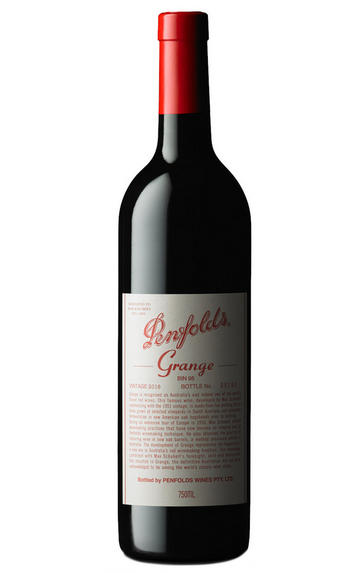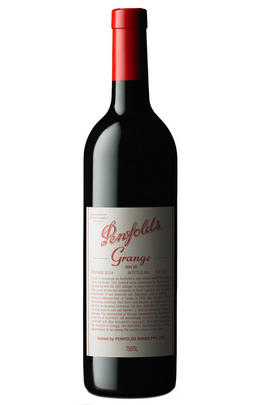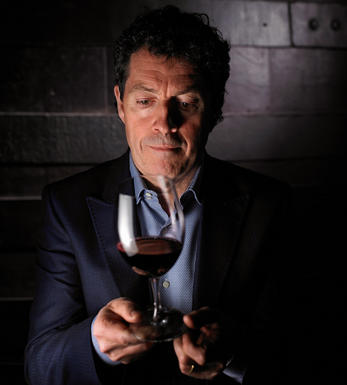
2017 Penfolds, Grange, Bin 95, Australia

Critics reviews
Carefully sourced fruit from Barossa Valley and McLaren Vale in the relatively cool vintage of 2017. 100% Shiraz (for only the seventh time after 1951, 1952, 1963, 1999, 2000 and 2011). Aged for 18 months in new American oak hogsheads.
Blackish garnet – very concentrated colour. Here we are verging on port country! Though it harks back to RWT. It's not one of the most dramatic Granges and is a little tight on the palate at the moment. It desperately needs time in bottle to show its mettle. Still very muscular and introvert, with some aromatic herbs but not much flesh for the moment. Wait! But for more immediate pleasure, head for RWT 2019.
Drink 2027 - 2047
Jancis Robinson, jancisrobinson.com (Jul 2021)
Strongly marked—as always—by its 100% American oak elevage, the 2017 Grange backs up the cedar and vanilla notes with ample blackberry and cassis fruit. Full-bodied, ripe and almost decadently creamy in the mouth, it's loaded with substance, concentrated and rich, yet—in the context of Grange—relatively light and elegant-seeming on the finish. Only the seventh-ever Grange to be exclusively Shiraz, it originates from Barossa Valley (86%) and McLaren Vale (14%); Shiraz from other growing regions in South Australia failed to make the grade this year.
Drink 2023 - 2040
Joe Czerwinski, Wine Advocate (Jul 2021)
James Suckling, jamessuckling.com (Aug 2021)
Drink 2025 - 2060
David Sly, Decanter.com (Jun 2021)
Drink 2028 - 2046
Josh Raynolds, vinous.com (Jul 2021)
About this WINE

Penfolds
Penfolds enjoys an iconic status that few New World producers have achieved. Established in 1844 at the Magill Estate near Adelaide, it laid the foundation for fine wine production in Australia.
The winemaking team is led by the masterful Peter Gago; it has the herculean task of blending the best wines from a multitude of different plots, vineyards and regions to create a consistent and outstanding range of wines. Its flagship wine, Grange, is firmly established as one of the finest red wines in the world.
Under Gago’s stewardship, the Penfolds range has evolved over time. Winemaking has moved away from New World heat and the sort of larger-than-life style that can mask individuality; the contemporary wines instead favour fine balance and typicity for the region or grape.

Barossa Valley
Barossa Valley is the South Australia's wine industry's birthplace. Currently into its fifth generation, it dates back to 1839 when George Fife Angas’ South Australian Company purchased 28,000 acres at a £1 per acre and sold them onto landed gentry, mostly German Lutherans. The first vines were planted in 1843 in Bethany, and by the 1870s – with Europe ravaged by war and Phylloxera - Gladstone’s British government complemented its colonies with preferential duties.
Fortified wines, strong enough to survive the 20,000km journey, flooded the British market. Churchill followed, between the Wars, re-affirming Australia’s position as a leading supplier of ‘Empire wines’. After the Second World War, mass European immigration saw a move to lighter wines, as confirmed by Grange Hermitage’s creation during the 1950s. Stainless-steel vats and refrigeration improved the quality of the dry table wines on offer, with table wine consumption exceeding fortified for the first time in 1970.
Averaging 200 to 400 metres’ altitude, the region covers 6,500 hectares of mainly terra rossa loam over limestone, as well as some warmer, sandier sites – the Cambrian limestone being far more visible along the eastern boundary (the Barossa Ranges) with Eden Valley. Following a diagonal shape, Lyndoch at the southern end nearest Gulf St Vincent is the region’s coolest spot, benefiting from sea fogs, while Nuriootpa (further north) is warmer; hot northerlies can be offset by sea breezes. The region is also home to the country’s largest concentration of 100-year-old-vine Shiraz, Grenache and Mourvedre.
Barossa Valley Shiraz is one of the country’s most identifiable and famous red wine styles, produced to a high quality by the likes of Rockford, Elderton, Torbreck and Dean Hewitson. Grenache and Mourvèdre are two of the region’s hidden gems, often blended with Shiraz, yet occasionally released as single vineyard styles such as Hewitson’s ‘Old Garden’, whose vines date back to 1853. Cabernet Sauvignon is a less highly-regarded cultivar.
Wines are traditionally vinified in open concrete fermenters before being cleaned up and finished in American and French oak barrels or ‘puncheons’ of approximately 600 litres. Barossa Shiraz should be rich, spicy and suave, with hints of leather and pepper.

Syrah/Shiraz
A noble black grape variety grown particularly in the Northern Rhône where it produces the great red wines of Hermitage, Cote Rôtie and Cornas, and in Australia where it produces wines of startling depth and intensity. Reasonably low yields are a crucial factor for quality as is picking at optimum ripeness. Its heartland, Hermitage and Côte Rôtie, consists of 270 hectares of steeply terraced vineyards producing wines that brim with pepper, spices, tar and black treacle when young. After 5-10 years they become smooth and velvety with pronounced fruit characteristics of damsons, raspberries, blackcurrants and loganberries.
It is now grown extensively in the Southern Rhône where it is blended with Grenache and Mourvèdre to produce the great red wines of Châteauneuf du Pape and Gigondas amongst others. Its spiritual home in Australia is the Barossa Valley, where there are plantings dating as far back as 1860. Australian Shiraz tends to be sweeter than its Northern Rhône counterpart and the best examples are redolent of new leather, dark chocolate, liquorice, and prunes and display a blackcurrant lusciousness.
South African producers such as Eben Sadie are now producing world- class Shiraz wines that represent astonishing value for money.


Buying options
Add to wishlist
Description
Carefully sourced fruit from Barossa Valley and McLaren Vale in the relatively cool vintage of 2017. 100% Shiraz (for only the seventh time after 1951, 1952, 1963, 1999, 2000 and 2011). Aged for 18 months in new American oak hogsheads.
Blackish garnet – very concentrated colour. Here we are verging on port country! Though it harks back to RWT. It's not one of the most dramatic Granges and is a little tight on the palate at the moment. It desperately needs time in bottle to show its mettle. Still very muscular and introvert, with some aromatic herbs but not much flesh for the moment. Wait! But for more immediate pleasure, head for RWT 2019.
Drink 2027 - 2047
Jancis Robinson, jancisrobinson.com (Jul 2021)
wine at a glance
Delivery and quality guarantee